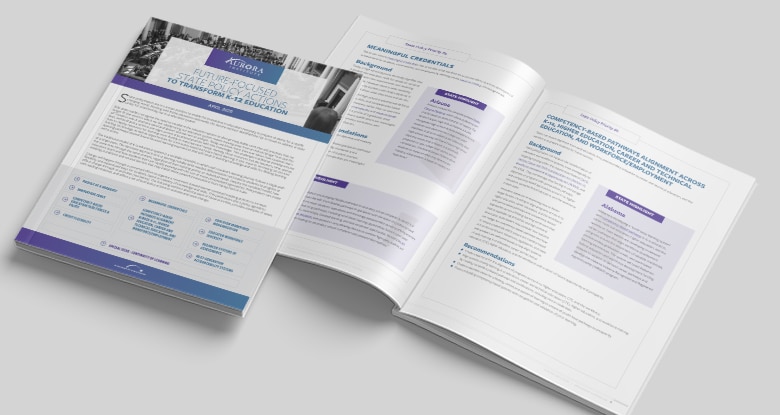Align K-12, Higher Education, CTE, and the Workforce with Competency-Based Pathways
Education Domain Blog
This post continues our special series on Future-Focused State Policy Actions to Transform K-12 Education. The series highlights policy issues to modernize our education system and align current educational practices with knowledge of how students learn best. We focus on leveraging state policy opportunities to increase access and open pathways toward future-focused learning experiences that build knowledge and skills for lifelong learning. Follow the links at the end of the post to read the other posts in this series.

Our economic, political, and civic engines depend upon a strong, adaptable, and capable citizenry. Our schools play an essential democratic role in stoking the fires of those engines. However, K-12 education is often siloed off from the systems to which we are sending our graduates, including college and careers. There are many opportunities in state and federal policy to strengthen a continuum between early education, K-12, postsecondary education to career and technical education (CTE), and the workforce to prepare students for future success.
Alabama, for example, has developed a “continuous learning system” with competency-based pathways in K-12 education, career technical education, higher education, and the workforce. State leaders there are developing in-demand career pathways that align workforce development programs around the attainment of valuable credentials, postsecondary graduation credit, and work-based learning experiences. The system is braiding Alabama’s federal education and workforce development funding streams to support in-demand career pathways and develop the Alabama Industry-Recognized and Registered Apprenticeship (AIRRAP) program.
In our 2020 state policy agenda, we highlighted the alignment of competency-based pathways across K-12, higher education, CTE, and the workforce as a critical priority to support a modernized education and align practice with the science. State policymakers who are supporting both the transformation of K-12 and workforce development systems can strategically target funding under federal Carl D. Perkins Career and Technical Education Act (Perkins V), Workforce Innovation and Opportunity Act (WIOA), and the Every Student Succeeds Act.
They can leverage that funding to encourage alignment of programs with personalized pathways and competency-based approaches across K-12, higher education, career/technical education, and the workforce in each state.
State leaders may consider how systems can realign for competency-based pathways and how to ensure credentials and licensure are mastery-based across the continuum. Governors, legislatures, and state policymakers are well-positioned to help align systems of early learning, K-12 education, CTE, higher education, and the workforce with a vision of future opportunity and prosperity.
Important policy actions include:
- Producing a statewide vision for a lifelong, continuous system of learning to ensure all youth have pathways to prosperity.
- Establishing a task force for the alignment of programs across K-12, higher education, CTE, and the workforce.
- Aligning systems of early learning, K-12 education, career and technical education, higher education, and workforce training using competency-based pathways and certifications, including micro-credentials.
- Applying a focus on building competency-based systems with recognition and validation of prior learning.
Learn More:
- Blog Post – Demonstration of Mastery Gives K-12 Credentials Their Meaning
- Blog Post – From Seat Time to Credit Flexibility in Personalized, Competency-Based Education
- Blog Post – Task Forces and Pilot Programs: Two Strategies to Enable Future-Focused, Student-Centered K-12 Education
- Blog Post – Innovation Zones Create Space for Local Educators to Lead Education Transformation
- Blog Post – Profile of a Graduate to Redefine Student Success for the Future
- Blog Post – Continuity of Learning Is an Urgent State Education Policy Priority
- Blog Post – Aurora Institute Announces Federal and State Policy Agenda